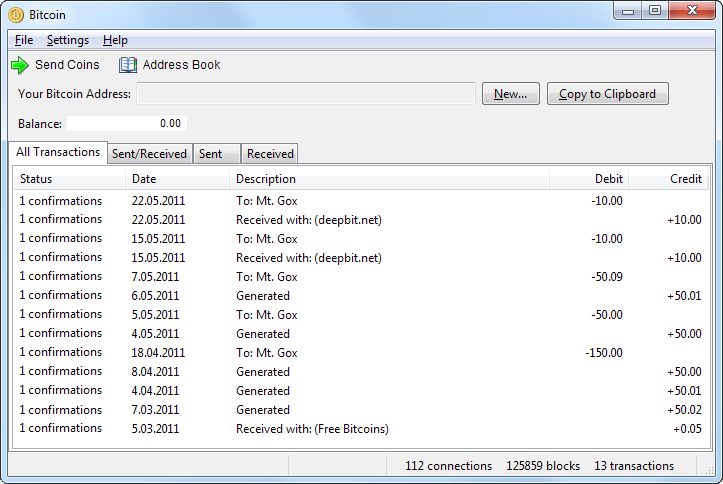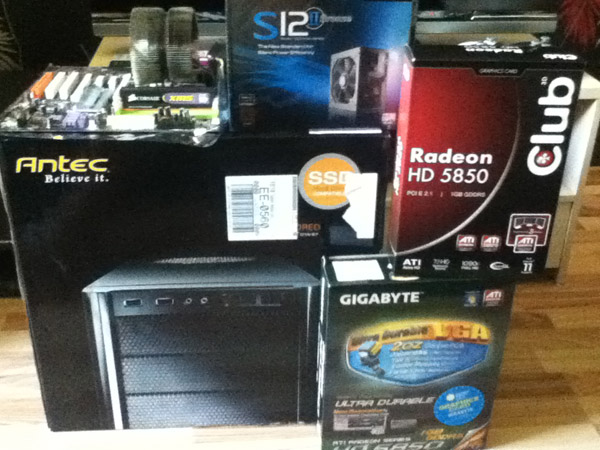KaurKuut.com
My thoughts, online.Bitcoin or how I made 400 euros in two months
May 24, 2011It was a cold evening on February 14, 2011 when I heard about a service called compute4cash that promised to pay US dollars in exchange for letting them run some calculations on my machine. Their software didn't require administrator privilges so I carefully started to try it out. After all, I could use some extra cash flow! I occasionally ran the program during the next two weeks, totalling at 62 hours of actual runtime on Feb 28th when I finally made a withrawal for $11.41. It worked! Not exactly the road to riches but still a reasonable sum for basically doing nothing. I continued to run the program at nights, but on the 5th of March I decided to investigate what the hell am I actually calculating and how much is this calculation worth for the organizers? After a few minutes of googling I found out that compute4cash is actually a rebranding of this thing called bitcoin.
So bitcoin is a digital currency and one of its main selling points is that it is decentralized. No single body has total authority, instead the network as a whole decides what is ok and what is not. Bitcoin is also semi-anonymous, allowing you to create new sender/receiver addresses for every transaction.
At its current state bitcoin is nowhere near ready for prime time. Both due to lack of reach and due to the cumbersome/non-existant software. I would pretty much ignore bitcoin if it would be just a regular currency replacement. Luckily it has more going for it. Namely the technical and economic architecture is brilliant. Bitcoin is designed in such a way that there will ever only be a potential maximum of 21 million coins available. These coins however are not given out all at once nor at completely random. Instead it is possible to take part in the bitcoin lottery and the lottery tickets can be purchased using computing power. Basically you run a program that tries to solve a difficult one-way math problem. By one-way I mean it is difficult to compute but trivial to verify. Your chance of solving this problem is completely random but if you do you have essentially won the lottery and get 50 coins. The more computing power you throw at this problem the more probable it gets that you will solve it. However the bitcoin network will adjust the difficulity of the problem after every 2016 solutions. The goal of the network is to adjust the difficulity so that 2016 solutions get found every two weeks. This difficulty adjustment is necessary to not exhaust the maximum supply of 21 million coins before the year 2140. In addition to that, the number of bitcoins you get by solving a problem is halved every 4 years. So the essence of bitcoin is scarcity, similar to gold. Even the mathematical problem solving to win some coins is called mining by most.
Originally it was common place to mine coins with a CPU. However it didn't take long for GPU optimized programs to show up. A GPU can solve this specific math problem much faster than a CPU. As more people moved on to GPU mining it quickly became clear that CPU mining was just wasting energy and no match whatsoever to powerful GPUs.
So here I was with my AMD Radeon HD 5850, just fresh off compute4cash and ready to cut the middle man. I quickly installed the official bitcoin client and a custom GPU miner and started mining. Luckily I solved my first block only two days after starting. This was most likely a key factor to keep me hooked and carry on. I mined and mined up until about the 7th of May. There had been a major influx of new miners and as such the difficulity had risen dramatically. At that point I decided to join a pool. Mining in a pool basically means that a group of people all try to solve the same problem and then share the gains proportionally based on how much computing power everyone provided, with the pool organizer taking a small cut for himself. I was willing to take a hit on my profits in regards to the pool tax because in return I received a much more stable income.

Now this is all great but I'm not running my GPU on full power for just a bunch of bitcoins. This is where Mt. Gox comes in. Mt. Gox is the premiere bitcoin exchange where people go to trade coins for USD. The exchange is not liquid at all and the volumes are really low. However still there are a bunch of speculators who are willing to buy and sell bitcoins for USD. I'm not interested in speculating on the market itself so I've cashed out at pretty random times at whatever price the coins would sell for.
18.04.11 150 BTC => 115.00 €
05.05.11 50 BTC => 109.49 €
07.05.11 50 BTC => 121.69 €
15.05.11 10 BTC => 44.54 €
22.05.11 10 BTC => 43.98 €
Total: 434.70 €
That's quite good for about 2 months of not playing graphically demanding games. It's really fuzzy what the future will bring to bitcoin so I wouldn't dare to invest any substantial amount that otherwise would go to good use elsewhere. However the money I've made thus far with bitcoin I'm willing to reinvest right back into the action and as such I've bought myself some new hardware that will play a role as a dedicated bitcoin miner. Having a quite limited budget I was determined to squeeze out as much performance per euro as possible. I did a lot of research on what GPUs can do how many calculations per second. Also the bitcoin problem involves integer mathematics not floating point, so I needed to only compare AMD cards and could completely ignore nVidia products. Having a decent understanding of the performance of a set of cards, I then gathered info on their power consumption and prices. Using all this info I generated some nice cost/benefit tables. Bitcoin mining doesn't really use any CPU power so basically any CPU would do. However it might be more beneficial to put multiple GPUs inside a single setup. So I looked at several different motherboards (some can fit even 5 GPUs!). Having multiple GPUs inside a single setup would require a lot of power and some excellent cooling, especially as I wanted to overclock the cards. Researching power supply units turned out to be a really intriguing experience. In the past I've never opted for the cheap ones because I knew that they suck but I didn't really know why they suck. Also with all the computers I've built in the past (tens of them) I've never really calculated the exact power needs of the components and how that power would be delivered and at what realiability and efficiency. Instead I've taken the easy road and just bought a high end model that will absolutely be more than I could use. This time however I was on a tight budget and building a very specific purpose machine that would be running in extreme circumstances so I couldn't just buy an over-the-top PSU nor a random low end one. On top of everything else I found out that even high end manufacturers lie about their products. For example Corsair likes to rate their PSUs at 30 degrees celsius, which isn't exactly a realistic temperature for heavy load usage.
After deciding on what components I need to buy I started scouting around my local used computer parts forum and found some pretty decent deals and the rest I bought new.
| CPU | AMD Athlon 64 X2 3800+, 2.0 GHz, Socket AM2 | 1 | 60.00 € |
| CPU cooler | Zalman CNP9500AM2 | 1 | |
| Motherboard | MSI K9N SLI Platinum | 1 | |
| RAM | Corsair 1GB XMS2 Extreme, DDR2, 800 MHz | 2 | |
| GPU | Gigabyte Radeon HD 5850 OC | 1 | 215.00 € |
| GPU | Club3D Radeon HD 5850 | 1 | |
| Storage | Kingston 8GB USB DataTraveler 100 G2 | 1 | 11.55 € |
| PSU | SeaSonic S12II-520 Bronze 520W | 1 | 61.50 € |
| Case | Antec Three Hundred | 1 | 58.30 € |
| Extra cooling | Nexus REAL SILENT 120mm D12SL-12 | 3 | 21.60 € |
| Dust filter | XILENCE 120mm case fan filter | 1 | 0.35 € |
| Total | 428.30 € | ||

If bitcoin mining continues to be profitable then this dedicated miner should serve me well and if not then I'm still OK because I bought it with money I got from bitcoin in the first place. However I'm a small fish in a big ocean of bitcoin miners and so as a bonus here is a video of a guy who got serious much earlier than me.

